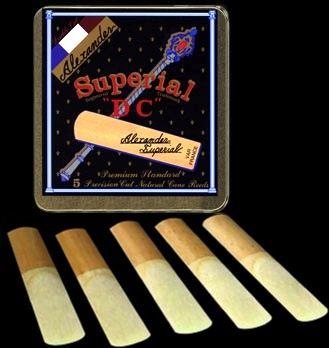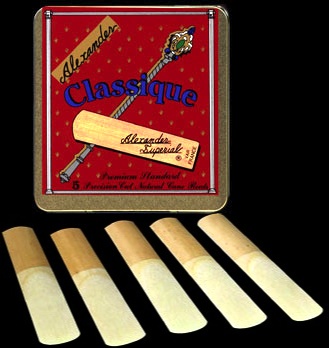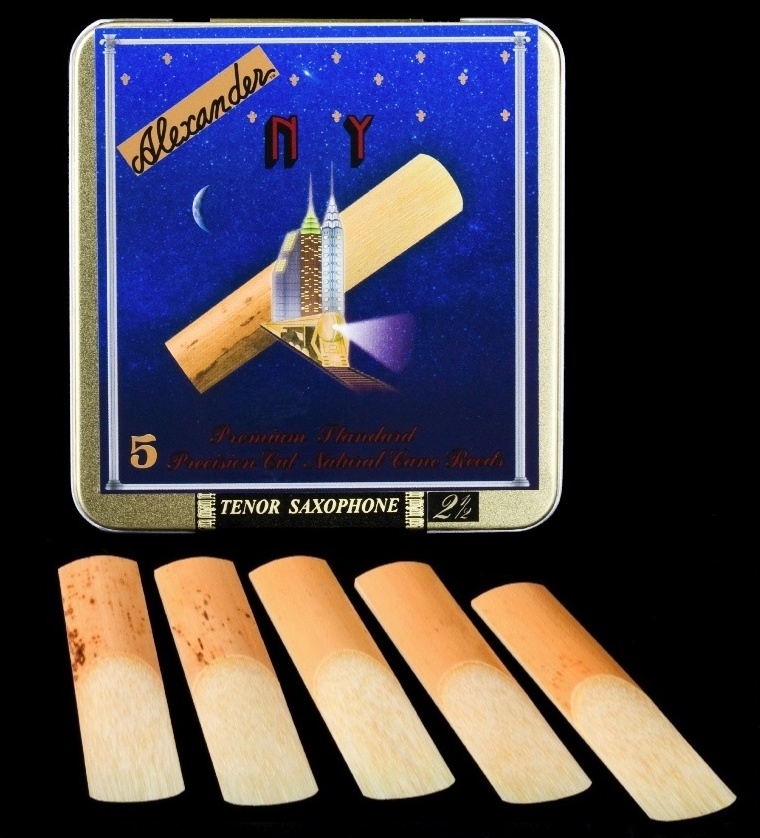| Q: What model and hardness of
Alexander Reeds should I try? A: There is no really simple answer to this but in general, it depends on the following: 1. What style of music are you
playing? As you can see from the "DC" page
of our site, we wanted this reed to have a kind of
Blue Note feel to it. But it is also a very versatile
reed with both resonance, power, and tonal presence,
and therefore will work well in other genres of music,
and even some classical players like them for certain
musical settings. NY
was created for and with the help of the late, great
saxophonist Michael Brecker, designed for power and
flexibility throughout the registers. It has the
strongest tip and is the hardest of our reeds. 2. What type of sound are you looking
for? In terms of the amount of wood on the tip,
sides, and vamp slope, the Alexander Reed palette
works like this:
This is a general description. "DC" is in the middle as far as hardness, but they all have tonal warmth at their center. You might want to think of it as a palette of paints...Superial would be the brightest colors, followed by "DC", with Classique and NY being the darker of the 4. 3. What mouthpiece are you using? The design of your mouthpiece, in a major way, can determine what type of sound and response you will get. There are many combinations for the reeds here, but in general small chamber/high baffle mouthpieces produce a bright, loud tone favoring the upper partials of the harmonic series, medium chamber mouthpieces offer some brightness, yet also enough chamber capacity and baffle depth to allow for more warmth in the tone and ease of playing both the upper and lower registers. This type of mouthpiece is most commonly used by woodwind players. Large chamber mouthpieces tend to be darker, fatter and warmer sounding (with the fundamental tone and lower harmonics emphasized), though some like vintage 4**** model or Tone Master Otto Links can be made to produce a tone that still retains a good amount of edge if the right reed/and embouchure combination is utilized, as John Coltrane did with his Tone Master. The legendary classical player Sigurd Rascher favored a large chamber mouthpiece, though the French Master Marcel Mule seems to have preferred the brighter Selmer metal mouthpiece with its more compact chamber. So generally speaking, in the extremes, using a bright, small chamber/high baffle mouthpiece with Superial, our brightest reed will give a very bright harmonic sound , and conversely a large chamber/low baffle mouthpiece with Classique will give a dark tone with the fundamental and lower overtones predominant. A medium chamber/baffle with "DC" lies in the middle., though all three models of reeds will work well on many different types of mouthpieces. 4. What is the tip opening of your
mouthpiece? In general, a small mouthpiece tip opening (the space between the tip of the reed and the mouthpiece) will require a hard reed, a medium opening will match well with a medium number reed and a wide open tip opening will be matched with a softer reed. Reed strength is not exactly the same for the various makers and please refer to our Reed Comparison Chart to find the closest match for your setup. Mouthpiece tip openings also vary. Some examples of pretty standard setups might be: Jazz Classical 5. How well is your embouchure
developed, how well do you support the tone through
your diaphragm, and how long have you been playing? Q: I want to
buy your reeds, but they aren't at my local store.
Where can I get them? Q: Do you make
sample packs of one or two reeds? Q: What is the
best way to prepare and break in your reeds? We stress that the correct break in for
reeds soft or just right resistance wise and
preparation will go a LONG way towards allowing them
to perform to their maximum capability. Some players just slap a brand new reed
which isn't too hard on the mouthpiece after putting
it in their mouth for a few seconds and begin blasting
away at triple forte and then expect it to last for
weeks. Can you imagine what would happen to your brand
new automobile's engine if you floored it down the
highway without any warm-up? And we are talking about
a fragile cane reed made from natural fiber and pulp
whose tip can be around the thickness of a piece of
paper....and this reed is furiously beating against
the side and tip rails of a mouthpiece (made from a
much harder material) thousands of times a minute!
Reed tips can be blown out just like engines can from
over stress too early on. So obviously, it makes sense to break softer reeds in more slowly and gently in the first few days if their longevity is one of your hopes. We know of many players who still have good luck not doing the break in and prep, but softer or just right reeds really do work better and longer if you give them time to adjust to their new life in the "fast lane" of the mouthpiece rails. Also, a light, warm water
soaking is better than using your mouth to moisten the
reeds for break in, as the acid in saliva can
contribute to their breakdown and early demise. Over
soaking them can likewise cause them to become
waterlogged and that's not the best condition for them
to be in either. So the best tip here is
balance, not too short and not too long. Remember too, that if you break in our reeds correctly they should harden up slightly after a day or so and then settle in. We've told this to many a player who later reported back to us that the prep and break in routines had made ALL the difference in how the reeds worked and lasted for them. Q: What is the
best way to store my wet, played reeds? One observation we've made is that keeping the reeds always a little moist and ligged on the mouthpiece may work well. Using a Ziplock bag with a little water in the bottom of it and putting the reed either ligatured on the mouthpiece, or just single reeds in seems to work well for some. While the drawbacks of this method could be mold and a bit of sogginess, there are some players who like the way the reeds feel when stored this way. We don't claim that everyone will prefer doing this, but the reason it seems to work well is that both the reed tip and table never completely dry out. So there are no "bacon tip" or warped reed table problems, both real hindrances to good response and for some that may outweigh any mold problems. If the reed table does not mate well with the mouthpiece table because of warping, or if the tip is not flat, your setup can feel quite sluggish. However, this "always moist" concept is not necessarily recommended for metal mouthpieces whose table plating has worn off. While we can't guarantee that all of you will like this method, you might try experimenting with it as we know several pro players who use it with positive results. Q: What is the
best way to store my unplayed reeds? Furthermore, the
reeds should never be stored near
sources of high humidity like humidifiers or
where water
is present. When being stored,
water should never come in contact
with the reed boxes/unplayed
reeds or mold/warpage can occur.
In addition, the reeds should not be exposed
to high heat or extremely dry
conditions. The ideal
way to store unplayed reeds is to keep them in a cool,
dry place which maintains
stable humidity
anywhere from around
50%-75%. There
is no absolute
in this so
you may want to
experiment to
find what
percentage works
best for you. Q: I just tried
your reeds and they didn't last as long I thought
they would...Is there something wrong with them? We have also seen numerous cases of players who either bought the wrong strength for their setup, were using a mouthpiece model or tip opening unsuited to them, or hadn't been playing with enough embouchure and diaphragmatic support. Lack of this support is by far the most common cause of going sharp, squeaking, and getting a thin, constricted tone (caused by a closed throat) because subconsciously, these players are using their jaw muscles to compensate for the tone going flat due to lack of this embouchure/diaphragm support, and the biting makes notes play sharp. And if they are using a mouthpiece which has a tip opening too large for them to handle, matters will be made worse. If a student or amateur who only plays a few hours a week is trying to blow in tune with a No. 8 Otto Link, for example, it might be extremely difficult for them to negotiate the kind of support and air flow that this mouthpiece would require and they probably would end up resorting to using their jaw to "bite" the note into tune. Learning how to blow with an open, relaxed throat and with proper diaphragm/embouchure support usually requires a good amount of concentrated "long tone" practice to master, and makes all the difference in the world how reeds will respond in the way they were designed to. Q: Your reeds seem to
play differently than they did before...for one
thing the stamp on the back looks different and
maybe the cut...Why did you change them? We also use the state of the art machinery in reed making for cutting the blanks into reeds and hardness grading them. However, every single reed blank cannot be made to be exactly like the one before and after it. If cane grew with perfect consistency in its organic make up (fibers and pulp) and the top of the line reed making machinery was laser perfect, maybe so. Yet our machines are quite a bit more accurate than those from the 20's-60's when all those phenomenal jazz and classical recordings were made, there's no doubt about it. Somehow those reeds must have been doing their job, because all those legendary players used them on their live performances and recordings and you can hear how well they sounded. Today we are trying to follow in the same footsteps of the proven reed tradition, but with improvements in the manufacturing process and players worldwide are using our reeds with great success in countless recording sessions and concerts. Now let's move on to the instrument and the setup (mouthpiece and ligature), which certainly has a lot to do with how well your reed will or won't perform to its maximum capabilities. First, are all the pads in your horn seating well? If not, it can feel like your reed is stuffy, or even dead, especially if the palm key pads, octave key vent or middle G# keys are not seating well. Does your neck set to the proper tightness or is it loose? Any gaps here will create a leaky seal, and this too might make you feel something is wrong with your reed or mouthpiece. Is the neck cork worn out? A cork that does not seal the mouthpiece internally can make the whole setup feel very sluggish and dead. Next, the mouthpiece; does your mouthpiece have any residue or film built up on the table? Even if you can't see it, the way your reed plays and how its hardness feels may be greatly affected if this film builds and hardens so that it becomes out of flat. Also, is the table flat to begin with? We've seen even brand new mouthpieces which sometimes have tables that aren't flat. If they are either concave or convex, this could cause all sorts of problems. And, is the table pitted? This is a common problem with some metal mouthpieces, especially ones in particular that are made of very soft material and the table can just wear out after some years. The same or even worse problems may be encountered if the mouthpiece table and/or rails are out of balance. They have to be measured by an expert with highly accurate gauges to tell their true condition and without a doubt the lay of the mouthpiece plays a major part in how well the reed seats. So we strongly recommend that you consult a reliable and experienced mouthpiece tech to be sure there might not be any problems here because believe me, mouthpiece, lig, cork, neck tenon and pad problems can often feel like reed problems. The ligature too can be a source of problems which may feel like one of the reed. We've run tests where it was apparent that the ligature had a great deal to do with how resistant the reed felt. Also, some ligs can wear out and exert a little more pressure to one side or the other or maybe just in the center of the reed which might also cause problems ranging from poor performance to outright squeaking. All of these points are critical because if even one of them is not in proper adjustment, it might feel as if there is something wrong with your reed. Or a few tiny leaks, coupled with a loose neck or worn out neck cork or ligature might compound to considerably affect the way your saxophone responds. Selmer Mark VI's, for example as magnificent as they are, have very thin tone holes, which can be quite sensitive to leaks. Make sure to keep all points of your setup train is tip top condition if you want your reeds to perform to their maximum capabilities. |
||||||||||



